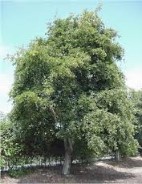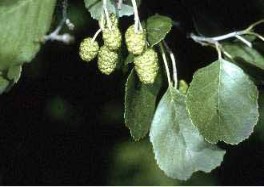Alder, alnus glutinosa
Tolerant of clipping and maritime exposure, the alder can be grown in a windbreak or a hedge.

 The trees are very quick to establish and will grow at a rate of 1 metre or more per year when young, growing up to about 20 m.
The trees are very quick to establish and will grow at a rate of 1 metre or more per year when young, growing up to about 20 m.
This is an excellent pioneer species for re-establishing woodlands on disused farmland, difficult sites etc. Its fast rate of growth means that it quickly provides sheltered conditions to allow more permanent woodland trees to become established. In addition, bacteria on the roots fix atmospheric nitrogen - whilst this enables the tree to grow well in quite poor soils it also makes some of this nitrogen available to other plants growing nearby.
Alder trees also have a heavy leaf canopy and when the leaves fall in the autumn they help to build up the humus content of the soil. Alder seedlings do not compete well in shady woodland conditions and so this species gradually dies out as the other trees become established. Because they tolerate very poor soils and also produce nitrogen nodules on their roots, alders are suitable for use in land reclamation schemes.
The leaves are clammy and, if spread in a room, are said to catch fleas and flies on their glutinous surface.The wood is very durable in water, elastic, soft, fairly light, easily worked, easily split. It is often used for situations where it has to remain underwater and is also used for furniture, pencils, bowls, woodcuts, clogs etc. It is much valued by cabinet makers. The wood also makes a good charcoal.
